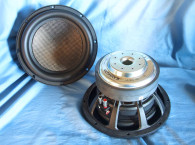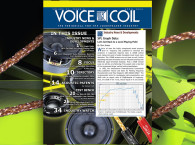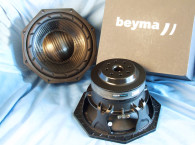
Headquartered in Sweden, Neotera was founded in 2019 by a fairly diverse group of loudspeaker/electronic design veterans. Neotera is self-described as: “An international group of like-minded individuals launched Neotera in 2019 to present a complete set of new technologies to the global audio industry intended to challenge the conventional thinking and deliver new and unique outcomes for both manufacturers and end users. These new technologies cover performance enhancing transducers, electronics software, and audio systems designs, which can be tailored to suit each application. The initial products were launched in 2023 with an extensive roll out plan to be initiated in 2024 targeted at both the professional and consumer audio industry.”
Founding partners for Neotera include Erik Thorsell (Thorsell invented and patented the popular “Fresh Air” car subwoofer system and is based in Sweden); Greg Turnidge (Turnidge is the Managing Director of Neotera and Blue Acoustics [Blueacs] and is based in Australia); and Maurizio Servadio (Servadio is the engineer who invented the Neotera Ultraflat technology and is based in Italy where the UF 295 CBS is manufactured). Interestingly, both Thorsell and Turnidge worked with Neville Thiele for years up to his passing, which is impressive. In addition, industry veteran David Stephens is Director of Sales & Marketing for Neotera.
Voice Coil’s Test Bench has explicated several thin-profile woofers over the years, including drivers from Dayton Audio, Prescient Audio, SB Acoustics, and Wavecor. Virtually all these previously featured woofers, including this month’s new UF 295 CBS, are subwoofers with the thin-profile aspect meant to complement shallow-depth mounting situations as well as provide low-frequency subwoofer category performance.

The rear surround is attached to a large secondary black anodized aluminum assembly that is glued to the rear cone surface. Since it creates a seal between the surround, cone, and motor assembly, it has a series 18 6.5mm diameter air vents that provide both thermal convection cooling and equalizing venting as the airspace volume changes. Figure 1 shows the details of the unique compliance system, which incidentally provides ±34mm of mechanical excursion without damage.

The motor structure is also very unique in that it uses a series of 72 38mm high neodymium (neo) N35 bar magnets for a total magnet mass of 1.4kg. The 38mm high neo magnets directly drive the 12mm high voice coil for a 13mm underhung physical Xmax. Interestingly, and undoubtedly the only solution, the entire 72 magnet motor is charged after assembly is completed using a massive 52 kilojoule magnetizer! Incidentally, the drivers are produced on a semi-automatic production line in an Italian loudspeaker factory. Remaining features include a 600W AES-rated power handling, a frame made of Zamak 5 zinc alloy, and a mechanical excursion of ±34mm.
I began characterizing the new UF 295 CBS subwoofer woofer using the LinearX LMS analyzer and the Physical LAB IMP Box (the same type of test fixture as a LinearX VI Box for measuring voltage and current separately). Sweeps were generated with the driver securely mounted in free air at 0.3V, 1V, 3V, 6V, 10V, 20V, and 30V. For the Thiele-Small (T-S) parameter calculation, measured Mmd was used rather than a single 1V added (delta) mass measurement. It should also be noted that this multi-voltage parameter test procedure includes heating the voice coil between sweeps for progressively longer periods to simulate operating temperatures at that voltage level (raising the temperature to the first- and second-time constants).
The 30V curves were too nonlinear to get a sufficient curve fit and were discarded. The remaining 12 stepped sine wave sweeps for each woofer were further processed with the voltage curves divided by the current curves to produce impedance curves. Phase curves were generated using the LEAP phase calculation routine, after which the impedance magnitude and phase curves plus the associated voltage curves were then copy/pasted into the LEAP 5 Enclosure Shop software’s Guide Curve library. This data was then used to calculate parameters using the LEAP 5 LTD transducer model.
Because most all manufacturing data is being produced using either a standard transducer model or in many cases the LEAP 4 TSL model, I also generated LEAP 4 TSL model parameters using the 1V free air that can also be compared with the manufacturer’s data. Figure 2 shows the UF 295 CBS’s 1V free-air impedance plot. Table 1 compares the LEAP 5 LTD and LEAP 4 TSL T-S parameter sets for the Neotera UF 295 CBS thin-profile subwoofer samples along with the Neotera factory data.


From the comparative data shown in Table 1 for the thin-profile Neotera UF 295 CBS 4Ω subwoofer, you can see that all four parameter sets for the two samples were very similar and correlated rather well with the factory data except for the Xmax number. The 16.5mm Xmax number from Neotera represents the excursion at 82% Bl (from Klippel analyzer data). While the physical underhung Xmax is 13mm, this is a motor structure that does not have the typical pole piece and gap format, and given its configuration, likely has a more robust fringe field. Because of this I used 14mm as the Xmax number for LEAP V box analysis, making Xmax+15% 16.1mm, close to the number given by Neotera.
Following my normal protocol for Test Bench testing, I used the sample 1 LEAP 5 LTD parameters and set up computer box simulations. Since Neotera supplied example sealed box design graphs for different volumes (6, 9, 12, 18, and 24 liters), I decided to do LEAP V simulations for 24 liters (0.84ft2) and 12 liters (0.42ft2), each with 50% fill material (fiberglass).
Figure 3 gives the enclosure simulation results for the Neotera UF 295 CBS at 2.83V and at a voltage level sufficiently high enough to increase cone excursion to Xmax+15% (16.1mm for UF 295 CBS). This resulted in an F3 of 26Hz (-6dB=23.3Hz) with a Qtc=1.9 for the 24-liter box, and -3dB=32Hz (-6dB=29Hz) with a Qtc=1.94 for the 12-liter box.

Increasing the voltage input until the approximate Xmax+15% maximum linear cone excursion point was reached resulted in 104dB at 36.25V for the 24-liter simulation, and 108dB at 37.5V for the 12-liter enclosure. Figure 4 shows the 2.83V group delay curve and Figure 5 shows the 36.25/37.5V excursion curve.


Klippel analysis for the Neotera UF 295 CBS subwoofer was performed this month by Redrock Acoustics (Patrick Turnmire) on a Klippel DA2 analyzer, which produced the Klippel data graphs given in Figures 6-9.
The Bl(X) curve for UF 295 CBS (Figure 6) depicts a broad and very symmetrical shape, with a small amount of offset. Looking at the Bl Symmetry curve, Figure 7 shows a fairly small 1.4mm Bl coil-out (forward) offset once you reach an area of reasonable certainty around 9mm, decreasing to a relatively small offset of 0.8mm at the physical 13mm Xmax.


Figure 8 and Figure 9 show the Kms(X) and Kms symmetry curves. The Kms stiffness of compliance curve (Figure 8) is somewhat symmetrical, with coil-out offset on the inward stroke and coil-in offset on the outward stroke. The Kms symmetry range curve (Figure 9) looks like the analyzer had difficulty resolving this behavior, and indeed, Patrick noted that toward the end of the test, the 2400W QSC amplifier was clipping, so no conclusions should be drawn from this data.


Displacement limiting numbers calculated by the Klippel analyzer for the UF 295 CBS for Bl was XBl @ 82% (Bl dropping to 82% of its maximum value) equal to 14.6mm for the prescribed 10% distortion level (the criterion for full-range drivers), and greater than 16.2mm for XBl at 70% for the subwoofer 20% distortion criteria, both numbers being greater than the physical Xmax. For the compliance, XC @ 75% Cms minimum for the 10% distortion criteria was greater than 16.2mm, which means the Bl is the somewhat more limiting factor for getting to the 10% distortion level.
Figure 10 gives the inductance curve Le(X) for the Neotera subwoofer transducer. Motor inductance will typically increase in the rear direction from the zero-rest position as the voice coil covers more of pole, however the UF 295 CBS does not use a pole piece motor structure, which means no saturated iron to create inductive distortion. (FYI, this is why the pole piece in the Purifi Audio woofer motor structure is partially composed on a neo magnet to lower distortion.)

What we do get is lower inductance variation from full in to full out travel, which is the goal you want to achieve. The UF 295 CBS inductance only varied from 0.10mH to 0.027mH from Xmax in to Xmax out, which is very minimal inductance change and indicates excellent inductive performance, obviously an affectation of this type of motor structure.
Since the UF 295 CBS is a subwoofer, I normally do not do frequency response or time-domain testing that you see with woofer analysis. Indeed, the US 295 CBS is a very high inductance narrow bandwidth device, and like many high inductance motor subwoofers, needs to be crossed over to a midbass device between 60Hz to no higher than 80Hz. Figure 11 shows a nearfield measurement done by Neotera with the microphone 63mm from the driver. This shows the UF 295 CBS about 6dB down at 60Hz from the high-pass knee at 22Hz.

For the last remaining series of tests, I initialized the Listen SoundCheck AudioConnect analyzer and SCM ¼” microphone (both provided courtesy of Listen, Inc.) to measure distortion and generate time-frequency plots. For the distortion measurement, the Neotera driver was mounted rigidly in free air, and the SPL set to 84dB at 1m (17.8V), using a pink noise stimulus. Then, the distortion was measured with the Listen microphone placed 10cm from the driver. Normally, I would have set the 1m SPL to 94dB, but due to the low efficiency and restricted bandwidth, this was the highest voltage level available for this test. This produced the distortion curves shown in Figure 12.

For more information, visit the Neotera website at
www.neoteraaudio.com, or contact David Stephens at david@neoteraaudio.com. VC
This article was originally published in Voice Coil, April 2024.







